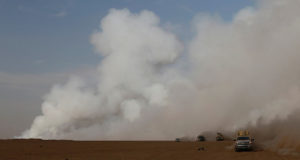by WorldTribune Staff, October 28, 2016
Clouds of toxic sulfur dioxide from a fire set by Islamic State of Iraq and Levant (ISIL) are moving across central Iraq and have reached southeastern Turkey.
The toxic clouds formed after ISIL jihadists on Oct. 21 set fire to a sulfur plant 40 kilometers (24.8 miles) south of Mosul.

Hundreds of Iraqis in areas hit by the toxic clouds have sought medical help due to breathing difficulties and nosebleeds.
Satellite images released by U.S. space agency NASA found the sulfur dioxide clouds had reached much of central Iraq, including Baghdad, Tikrit, Kirkuk and Mosul as well as parts of Turkey’s southeast.
Gokhan Abur, the meteorology editor of Turkish broadcaster NTV, said that, starting from Oct. 27, winds will blow from the southeast and bring the toxic smoke along with rainclouds.
“The rain will increase humidity in the area. Humidity is water vapor. When H2O merges with SO2 and water vapor, it will form H2SO4, the acid known as sulfuric acid. As the smoke gets closer to us, it will be completely inside our border on Friday and Saturday, when the downpours will be effective,” Abur said.
“These raindrops will be loaded with acid. As NASA had stated, the most dangerous thing for us is that these acid rains will burn the plants in the region. Therefore it will both burn the plants on ground level and harm trees,” he added.
Abur noted that a theory assumes that the toxic clouds loaded with SO2 would remain in the air for seven days, and a large part of the clouds will enter this chemical reaction.
Along with sulfur deposits, ISIL also set oil wells on fire to create a smokescreen to avoid U.S.-led coalition airstrikes.
